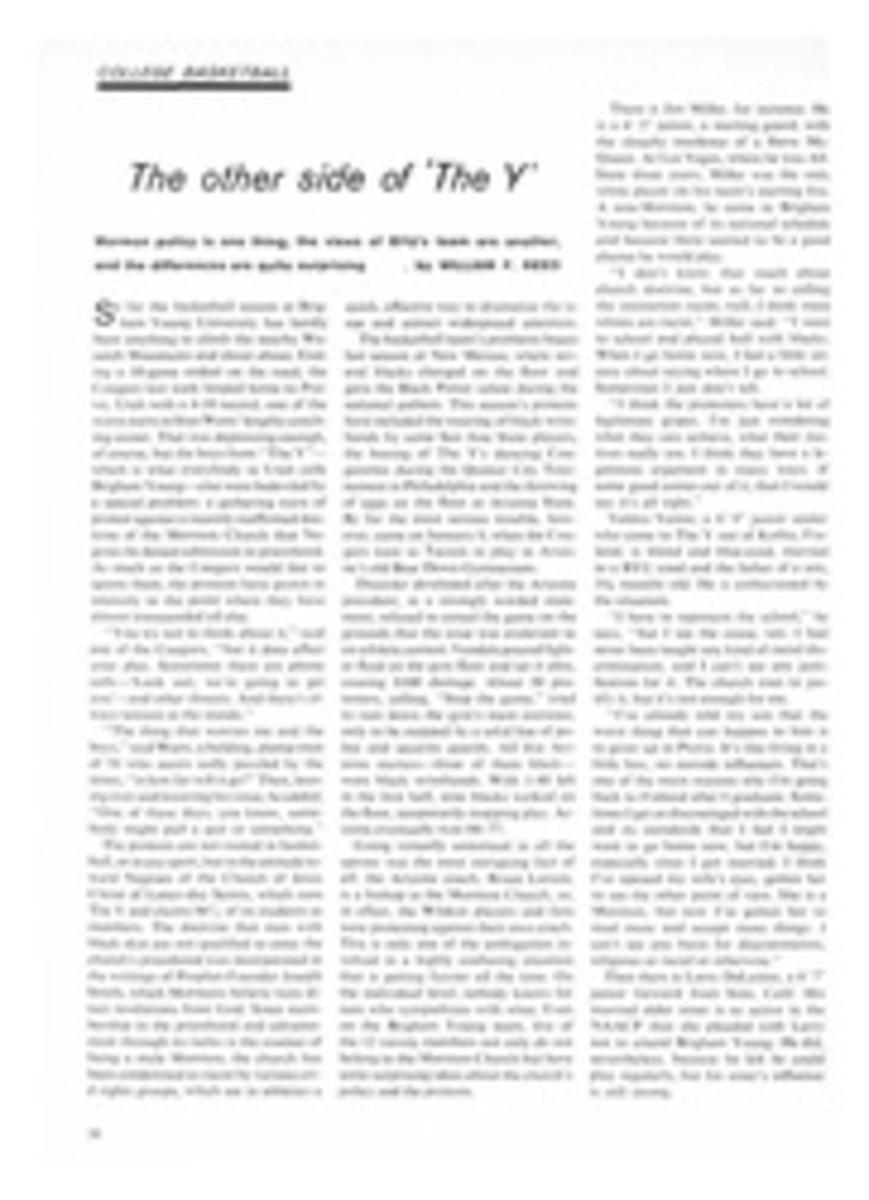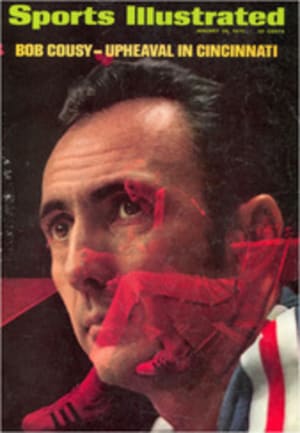
The other side of 'The Y'
So far the basketball season at Brigham Young University has hardly been anything to climb the nearby Wasatch Mountains and shout about. Ending a 10-game ordeal on the road, the Cougars last week limped home to Provo, Utah with a 4-10 record, one of the worst starts in Stan Watts' lengthy coaching career. That was depressing enough, of course, but the boys from "The Y"—which is what everybody in Utah calls Brigham Young—also were bedeviled by a special problem: a gathering wave of protest against a recently reaffirmed doctrine of the Mormon Church that Negroes be denied admission to priesthood. As much as the Cougars would like to ignore them, the protests have grown in intensity to the point where they have almost transcended all else.
"You try not to think about it," said one of the Cougars, "but it does affect your play. Sometimes there are phone calls—'Look out, we're going to get you'—and other threats. And there's always tension in the stands."
"The thing that worries me and the boys," said Watts, a balding, plump man of 58 who seems sadly puzzled by the times, "is how far will it go?" Then, leaning over and lowering his voice, he added, "One of these days, you know, somebody might pull a gun or something."
The protests are not rooted in basketball, or in any sport, but in the attitude toward Negroes of the Church of Jesus Christ of Latter-day Saints, which runs The Y and claims 96% of its students as members. The doctrine that men with black skin are not qualified to enter the church's priesthood was incorporated in the writings of Prophet-Founder Joseph Smith, which Mormons believe were direct revelations from God. Since membership in the priesthood and advancement through its ranks is the essence of being a male Mormon, the church has been condemned as racist by various civil rights groups, which see in athletics a quick, effective way to dramatize the issue and attract widespread attention.
The basketball team's problems began last season at New Mexico, where several blacks charged on the floor and gave the Black Power salute during the national anthem. This season's protests have included the wearing of black wristbands by some San Jose State players, the booing of The Y's dancing Cougarettes during the Quaker City Tournament in Philadelphia and the throwing of eggs on the floor at Arizona State. By far the most serious trouble, however, came on January 8, when the Cougars went to Tucson to play in Arizona's old Bear Down Gymnasium.
Disorder developed after the Arizona president, in a strongly worded statement, refused to cancel the game on the grounds that the issue was irrelevant to an athletic contest. Vandals poured lighter fluid on the gym floor and set it afire, causing $100 damage. About 50 protesters, yelling, "Stop the game," tried to ram down the gym's main entrance, only to be stopped by a solid line of police and security guards. All five Arizona starters—three of them black—wore black wristbands. With 1:40 left in the first half, nine blacks walked on the floor, temporarily stopping play. Arizona eventually won 90-77.
Going virtually unnoticed in all the uproar was the most intriguing fact of all: the Arizona coach, Bruce Larson, is a bishop in the Mormon Church, so, in effect, the Wildcat players and fans were protesting against their own coach. This is only one of the ambiguities involved in a highly confusing situation that is getting fuzzier all the time. On the individual level, nobody knows for sure who sympathizes with what. Even on the Brigham Young team, five of the 12 varsity members not only do not belong to the Mormon Church but have some surprising ideas about the church's policy and the protests.
There is Jim Miller, for instance. He is a 6'5" junior, a starting guard, with the slouchy insolence of a Steve McQueen. At Las Vegas, where he was All-State three years, Miller was the only white player on his team's starting five. A non-Mormon, he came to Brigham Young because of its national schedule and because there seemed to be a good chance he would play.
"I don't know that much about church doctrine, but as far as calling the institution racist, well, I think most whites are racist," Miller said. "I went to school and played ball with blacks. When I go home now, I feel a little uneasy about saying where I go to school. Sometimes I just don't tell.
"I think the protesters have a lot of legitimate gripes. I'm just wondering what they can achieve, what their motives really are. I think they have a legitimate argument in many ways. If some good comes out of it, then I would say it's all right."
Veikko Vainio, a 6'9" junior center who came to The Y out of Kotka, Finland, is blond and blue-eyed, married to a BYU coed and the father of a son, 3½ months old. He is embarrassed by the situation.
"I have to represent the school," he says, "but I see the cause, too. I had never been taught any kind of racial discrimination, and I can't see any justification for it. The church tries to justify it, but it's not enough for me.
"I've already told my son that the worst thing that can happen to him is to grow up in Provo. It's like living in a little box, no outside influences. That's one of the main reasons why I'm going back to Finland after I graduate. Sometimes I get so discouraged with the school and its standards that I feel I might want to go home now, but I'm happy, especially since I got married. I think I've opened my wife's eyes, gotten her to see the other point of view. She is a Mormon, but now I've gotten her to read more and accept more things. I can't see any basis for discrimination, religious or racial or otherwise."
Then there is Larry DeLaittre, a 6'7" junior forward from Simi, Calif. His married older sister is so active in the NAACP that she pleaded with Larry not to attend Brigham Young. He did, nevertheless, because he felt he could play regularly, but his sister's influence is still strong.
"I get phone calls from her almost every week, wanting to know if it's really that bad," said DeLaittre. "I really do sympathize with the protesters because I've been brought up that way. I feel sorry for anybody like that—Indians, blacks, I see their point and I really get uptight when we come out and I see the cold stares. I want to grab hold of somebody and yell, 'I'm Catholic, I'm Catholic.' "
The Cougars got on a chartered bus last Thursday and rode 125 miles up the Wasatch Range to Logan, Utah, where they played Utah State University that night. The boos were only perfunctory and in honor of an ancient and bitter rival. This was immensely relieving to the Utah State coach, LaDell Andersen, who is also a Mormon, and not very surprising to the Cougars. "Logan is a lot like Provo—predominantly Mormon," said DeLaittre before the game.
Nevertheless, Utah State's best players—All-America Forward Marv Roberts and Forward Nate Williams—are black, and they admitted to being especially pleased with the Aggies' 97-94 victory. "The Y is not just another ball club," said Roberts. "When you play The Y, it's a special challenge to the black players. You try harder, you try to beat this thing by beating their pants off on the court."
"I don't like some of the rules they put down," said Williams, "but it's a private institution and they're free to do what they want. If they don't want blacks, then I don't want to go there. But I play my heart out against them. What they're saying is the white athlete is the best athlete, and I want to prove that's not necessarily so."
There is hope in Provo that a new divine revelation may, in the next decade, admit blacks to the priesthood. The death Sunday of President David McKay, the church's 96-year-old president and revelator, could open the way to such a revelation. Polygamy, once a pillar of Joseph Smith's theological structure, was outlawed as the result of a revelation in 1890. If the black barrier should similarly be eliminated, nobody will be happier than The Y's athletic department. As Watts says, "I've always felt the field of competition is the wrong place to settle racial or religious issues." Amen, coach, amen.
PHOTO
JIM MILLER TRIES TO FAKE UTAH STATE'S NATE WILLIAMS (22) IN THE Y'S LOSS

